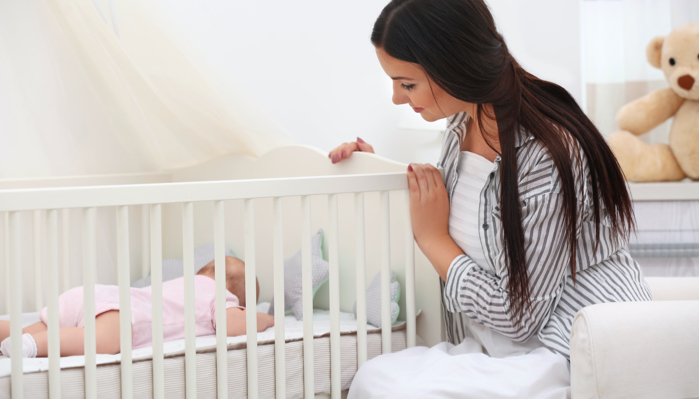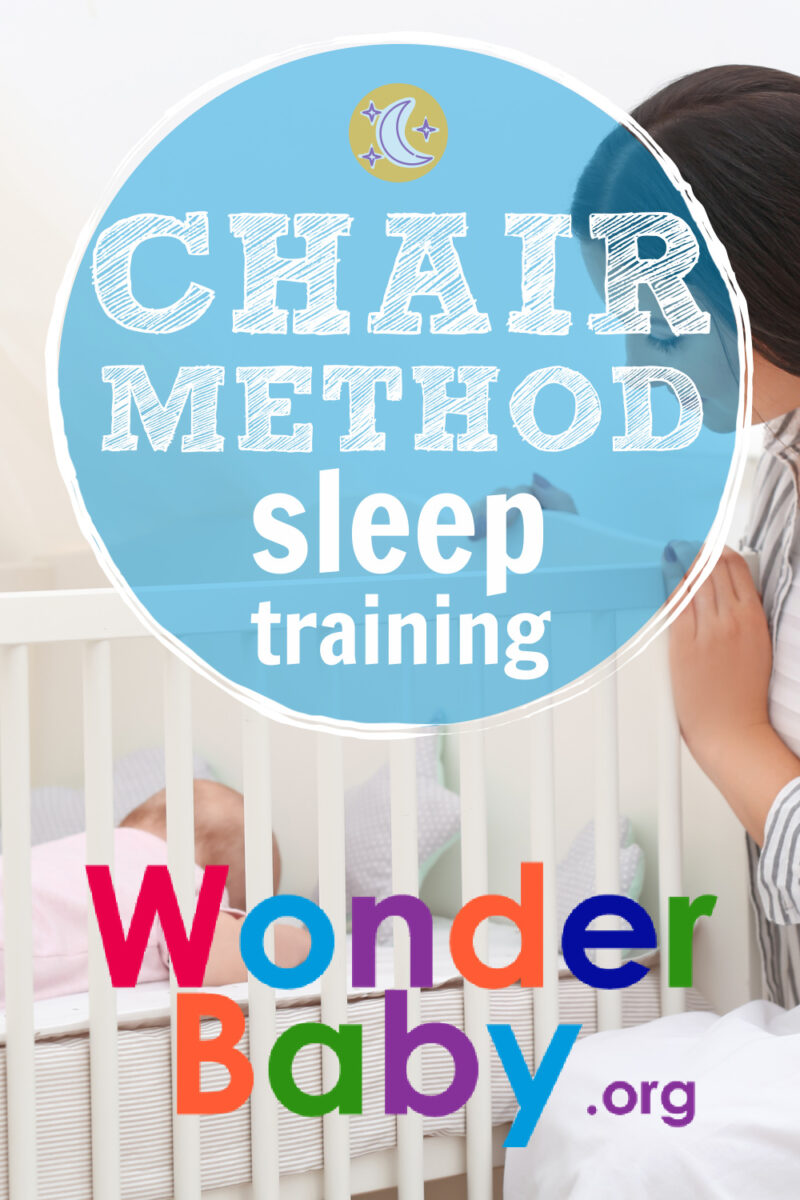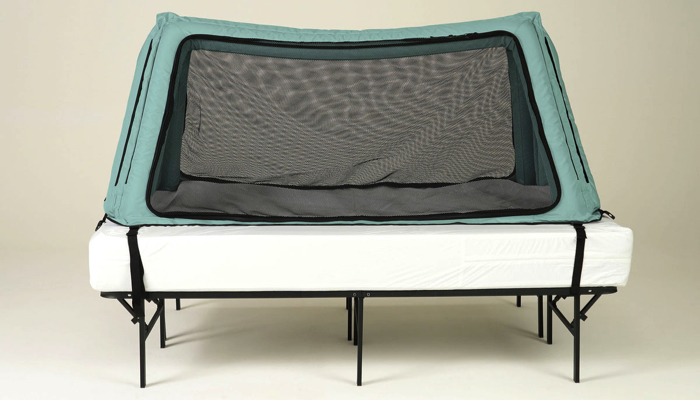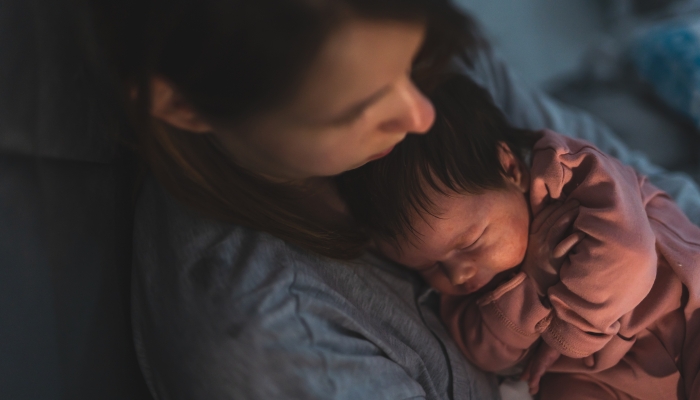Chair Method Sleep Training: A Guide for Sleepy Parents

This post may contain affiliate links; please see our terms of use for details.
- Chair method sleep training is a gentle sleep training technique that gradually teaches your baby to sleep on their own.
- Chair method sleep training allows you to stay in the room as your baby learns to self-soothe and settle to sleep independently.
- If you’re patient and consistent, the Chair method of sleep training can help your baby start to sleep on their own in as little as two weeks.
You spend what feels like hours every bedtime helping your baby get to sleep, only for them to wake in the night, two, three, even four times. You try everything—singing, rocking, holding, feeding—until they finally fall asleep again. You’re exhausted the next day, and as bedtime approaches, a familiar dread creeps in as you face another evening of desperately trying to get your baby to sleep.
Sound familiar? Then it may be time to start sleep training.
Chair method sleep training, also known as the “disappearing chair” or the “sleep lady shuffle,” is a gentle and effective way to sleep train that lets parents stay in the room to support their little one as they learn to get to sleep. There are so many sleep training methods out there it can be hard to know where to begin.
You’ve probably heard of No Cry sleep training, the Ferber method, the Pick Up Put Down method, and the Fading method. But If you feel anxious about leaving your baby on their own to sleep train and you’re eager to minimize crying at bedtime, the Chair method may be for you.
What is the Chair Method of Sleep Training?
The Chair method isn’t a complicated process to master. All you need is a chair next to your baby’s crib, some patience, and some time to use the method consistently. You sit in the chair next to the crib so your baby is aware of your presence as they try to get to sleep, and you can soothe them if they cry.
In contrast to the cry it out method, you can stay in the room with your baby if they’re fussing or upset. Every few days, you move the chair farther away from the crib until your baby learns that they can fall asleep on their own without help from you. The goal is to move your chair until it’s out of the room entirely and your little one has learned to sleep by themselves.
Some parents insist that the Chair Method and other types of fading sleep training aren’t as effective as simply letting your baby cry themselves to sleep, but the research doesn’t necessarily support this claim. Macall Gordon, M.A., certified pediatric sleep consultant and Senior Lecturer for the Department of Applied Psychology at Antioch University, points out that “while the Cry It Out (CIO) method is suggested as the most effective intervention, it comes out as no better than any other sleep training methods when compared side by side.” Gordon also cites a recent study showing that “a fading approach worked just as well (and on some variables even faster) than extinction sleep training and reduced mom’s depression and stress more effectively.”

How Does Chair Method Sleep Training Work?
To get started with Chair method sleep training, first place a chair next to the crib. Then, get your baby ready for bed with your usual bedtime routine. Put your baby down in the crib while they are still awake. Make sure to start on a day when your baby has napped well so that they’re not overtired or irritable.
Next, take a seat in the chair next to the crib, and stay as calm, still, and quiet as you can. Try not to overstimulate your baby by making eye contact or talking to them. You can stare at the wall or even close your eyes to signal to your baby that you are not there to play and that it’s time to quiet down for sleep.
If your baby cries, you can soothe and comfort them, but then sit back down in the chair while they try to settle themselves. Wait in the chair until your baby falls asleep. You are then free to leave the room.
If your baby wakes up and cries, you can go back into the room, comfort them, and again sit in the chair quietly and calmly until they fall asleep. Repeat this process as necessary through the night.
After the first few nights, move the chair farther away from the crib. Continue sitting in the room and comforting your child if needed while they self-soothe until they fall asleep. A few nights later, move the chair halfway to the door. Your goal is to move the chair closer to the door of your baby’s room every few nights until, after about two weeks, you have reached the doorway.
Finally, you’ll move the chair out of the room entirely. You can continue to re-enter the room if your baby cries through this process so that they know you are there to support them, but they will also eventually learn that they can get themselves to sleep.
At What Age Can I Start Using the Chair Method?
Generally, babies are developmentally ready for sleep training using the Chair method or other techniques at about four to six months old. You can also use Chair method sleep training with babies who need help settling down for naps or with toddlers who need help getting themselves to sleep.
All babies are different, so if your baby won’t sleep, it’s always a good idea to check with your pediatrician first before starting to sleep train.
How Long Does the Chair Method Take?
The Chair method may take a bit longer than some other sleep training methods because it is a gradual approach to training your child to sleep on their own. However, you can generally find success with this gentle sleep training technique in about two weeks if you are consistent and patient with it.
What If the Chair Method Isn’t Working?
The Chair method might not work for every baby. For some children, the presence of a parent when they are trying to fall asleep can be too distracting or overstimulating. Having a parent in the room, even if they’re quiet, can keep some children awake.
If your baby or toddler is still having trouble falling or staying asleep while practicing the Chair method, you may want to try a different sleep training method.
Many parents swear by leaving their babies to cry it out at bedtime until they’ve learned to get to sleep on their own. If that’s not for you, then you might consider the Ferber method, also known as “cry and console.” This is a more gradual version of crying it out, advocated by Dr. Richard Ferber in his bestselling parent handbook, Solve Your Child’s Sleep Problems.
If you want to minimize crying at bedtime, the pick-up put-down method and the bedtime fading method are other sleep training methods you can try.
Who Should Use Chair Method Sleep Training?
The Chair method is effective for babies who find the presence of their parents at bedtime calming rather than overstimulating. It is a suitable method for parents who can commit at least two weeks to patient and consistent practice of the technique every night.
It’s also good for parents who don’t like the idea of crying it out and feel more secure if they can stay in the room to support their babies as they learn to sleep independently.

Related Posts

Sleep, Special Needs
Safe Place Bedding Travel Bed Review
Traveling with a special needs child can be stressful! Having a safe, durable, and easy to use travel bed can make traveling so much easier!

Sleep, Special Needs
Sleep Regimen for Premature Babies: Special Considerations
It can take premature babies much longer than their full-term peers to sleep for long stretches. A preemie sleep schedule may encourage better sleep.

Sleep
Mastering the Bedtime Routine: 3 Tips for a Peaceful Night’s Sleep
From around six weeks, a newborn bedtime routine can help your baby learn the difference between day and night and prepare for a restful night’s sleep.